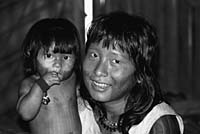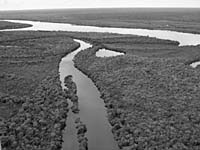In 1989, two years after his first visit to the Amazon, singer/songwriter Sting co-authored a book called "Jungle Stories: The Fight for the Amazon" (Barrie & Jenkins). In the book he writes, "To visit the forest just once is to be haunted forever after by its mysterious beauty and to be made aware of just how important its preservation is to everyone on the planet."
In February of the same year, Sting and Chief Raoni of the Kayapo tribe visited Japan as part of a world tour to publicize the destruction of the Amazon rain forests. Kenko Minami, a Japanese concert promoter, was asked to help coordinate the tour, and, like Sting, her life changed forever.
Minami had never met anyone so frightening and yet so gentle as Raoni, and when she shook his hand, she felt a mystical connection to his rain-forest home. Three months later, in May 1989, Minami established the Nettai Shinrin Hogo Dantai, the Rain Forest Foundation of Japan (RFJ), to raise awareness of the Amazon and to help protect its indigenous peoples.
Minami, 57, has now made 20 trips to Brazil, staying with the Kayapo and Xingu tribes for two to three months each visit.
Sadly, in her years as director of RFJ, conditions in the Amazon have only worsened. Despite decades of international hand-wringing, little has been done to stem the destruction caused by developers, miners and the landless poor.
"The Amazon ecosystem is unique even in Brazil. During the ice ages the area remained green, so the forests are full of invaluable genetic resources, truly unusual plants and animals. As a result, Brazil, too, wants to protect the area as a 'show window' of conservation and a source of genetic material. But poachers are increasingly moving into the park to steal unique animal species and exotic woods, such as mahogany," she said in a recent interview.
More destructive are the daily fires and the bulldozers that drag massive chains through the jungles uprooting whole swaths of trees and laying waste to as many as 100 hectares of forest each day. "Every year an area equal to about 21,000 Tokyo Domes disappears from the Amazon as the forests are turned into farms, many of them for soybeans that are sold to Japan," Minami explained.
Last year, 26,130 sq. km of Amazonian rain forest were cleared, the second-highest total since 1994 when 29,000 sq. km were destroyed, according to Brazil's Environment Ministry.
Other threats to the forests and the native Indios population include highway construction, dams, clearing for cattle grazing, logging, mining (iron ore, bauxite and gold), pollution (toxic mercury is used in gold mining) and diseases such as malaria, tuberculosis, influenza and venereal diseases brought in by outsiders.
Perhaps the only fact more shocking than the ongoing destruction is that it has continued despite decades of awareness that the Amazon is critical to our planet's health. The Amazon Basin contains about half of the world's remaining tropical forests; it produces almost a third of the oxygen we breathe; and it is home to as much as half of all the Earth's genetic resources (plant and animal), according to RFJ.
In fact, many experts believe that these forests contain cures for diseases, such as cancer and AIDS, and yet just 2 percent of the genetic material in the region has been identified. Only Indio medicine men, who can recognize more than 6,000 plant species, know the medicinal qualities of these plants.
"The only protection the forest has is the Indians," writes Sting -- and the Brazilian government agrees, in theory.
In 1992, at the United Nations Earth Summit held in Rio de Janeiro, Brazil's then President Fernando Collor de Mello promised that his country would set aside 10 percent of its entire land area for the sole use of indigenous peoples. To date, however, only 4 percent has been officially demarked, while the other 6 percent, a total of 238 areas, remains unprotected, according to Minami.
It is estimated that 500 years ago as many as 10 million Indios lived in the Amazon Basin. Today, several hundred thousand remain in 200 tribes scattered across the Amazon. The Yamomami are the largest group, about 20,000 individuals, while the Kayapo total 15,000.
Some might call the Kayapo lucky. They live in Xingu National Park, which covers 180,000 sq. km and is home to 18 tribes of Indios, totaling about 20,000 individuals
"I want to trust the government," says Chief Raoni in "Jungle Stories." "I keep hoping that they will set down our frontiers once and for all. [But] if we lose our land, the white man will destroy the whole forest. And then, where will we go to hunt the tapir, the ant bear, the panther? What will we eat when there is no game left?"
Raoni's words are hauntingly reminiscent of a letter written to the president of the United States in 1854 by Chief Seattle, a Native American: "What is man without the beasts? If all the beasts were gone, men would die from a great loneliness of the spirit. For whatever happens to the beasts, soon happens to man."
RFJ has sponsored numerous initiatives, including medical support, conservation activities and most recently a new school for Indio children funded with Japanese government assistance.
Still, Minami believes each of us must reconsider our values and embrace the changes that need to be made if we are going to conserve the Amazon, and the Earth, for future generations. "This planet is all one body. If we cut off one part of that body, the rest of the body will suffer. This is the awareness we need to develop," Minami urged.
As Chief Seattle wrote, more than 150 years ago, "The Earth does not belong to man, man belongs to the Earth. All things are connected. Whatever befalls the Earth, befalls the sons of the Earth. Man did not weave the web of life, he is merely a strand in it. Whatever he does to the web, he does to himself."



















With your current subscription plan you can comment on stories. However, before writing your first comment, please create a display name in the Profile section of your subscriber account page.